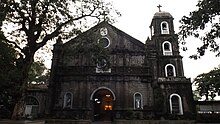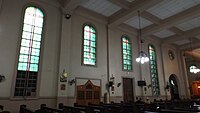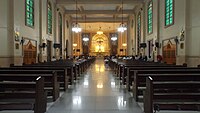Cainta Church
14°20′38″N 121°39′18″E / 14.3440°N 121.655°E
| Cainta Church | |
|---|---|
| Our Lady of Light Parish Church | |
| Iglesia de Madre Santísima de la Luz | |
Simbahan ng Caintâ | |
 Facade of the Cainta Church | |
| Location | A. Bonifacio Ave., San Andrés, Cainta, Rizal |
| Country | Philippines |
| Denomination | Roman Catholic |
| History | |
| Status | Active |
| Founder(s) | Jesuits |
| Consecrated | February 25, 1968 (reconstructed church) |
| Architecture | |
| Functional status | Church |
| Heritage designation | Marked Historical Structure |
| Designated | 2007 |
| Architect(s) | Fr. Gaspar Marco, S.J., (first church) Arch. Galo Ocampo (reconstructed church |
| Architectural type | Baroque Church |
| Style | Renaissance revival architecture |
| Groundbreaking | 1707 (first church) 1966 (reconstructed church) |
| Completed | 1716 (first church) 1968 (reconstructed church) |
| Demolished | 1899 (first church) |
| Specifications | |
| Capacity | 2,500 people (reconstructed church) |
| Length | 144 feet (44 m) (first church) 223 feet (68 m) (reconstructed church) |
| Width | 48 feet (15 m) (first church) 138 feet (42 m) (reconstructed church) |
| Height | 36 feet (11 m) (first church) 34.4 feet (10.50 m) (reconstructed church) |
| Number of domes | One (first church) None (reconstructed church) |
| Number of spires | One |
| Materials | Stone and reinforced concrete |
| Administration | |
| Archdiocese | Archdiocese of Manila |
| Diocese | Diocese of Antipolo |
| Parish | Our Lady of Light |
| Clergy | |
| Archbishop | His Eminence Antonio Cardinal Tagle |
| Bishop(s) | Most Rev. Gabriel V. Reyes |
| Priest in charge | Rev. Fr. Nolly C. Buco, JCD |
| Laity | |
| Servers' guild | Confradia dela Madre Santissima del Lumen |
Cainta Church, ecclesiastically known as Our Lady of Light Parish Church (Spanish: Iglesia de Madre Santísima de la Luz) stands as one of the oldest churches established in the province of Rizal, Philippines. It is located along Andres Bonifacio Avenue in Barangay San Andres. The church also operates a neighboring school, Cainta Catholic College.
From its time of erection as a parish in 1760 until 1983, it belonged to the Archdiocese of Manila. It was placed under the newly created Diocese of Antipolo in 1983, which is now headed by Most Rev. Gabriel V. Reyes, together with his Auxiliary Bishop Francisco M. De Leon. The present parish priest is Rev. Fr. Nolly C. Buco, JCD.
History
The stone church of Cainta was first built by Fr. Gaspar Marco, a Jesuit priest in 1707, which was initially named after its patron Saint Andrew the Apostle. The construction of the stone church was designed by Fr. Juan de Salazar, S.J. and was completed during the time of Joaquin Sanchez, S.J. in 1716 while he was still the parish priest.[1]
In 1727, a painting of Our Lady of Light was brought in from the Kingdom of Sicily (today part of Italy) and was chosen as the new patroness of the church. In 1760, the church was officially declared a separate parish.[2]
On February 23, 1853, an earthquake damaged the church building. Its roof and one wall collapsed while the walls of the parish rectory or convent sustained cracks.[1]
By 1884 or even earlier, the parish was already named as Our Lady of Light (Virgen ng Caliuanagan or Madre Santissima del Lumen in Tagalog and Spanish languages), as attested on the August 5, 1884 letter by the pastor of Cainta Don Mariano de San Juan to the Archbishop of Manila, Fray Pedro Payo, O.P..[3]
Filipino-American War
During the Filipino-American War in March 1899, the church and parish rectory of Cainta were burned down with the original picture of the Our Lady of Light, a casualty of the fire. The stones of the church walls were later used to build roads. The only mark left of its Jesuit beginning was attached at the top portion of the church's façade - the monogram of the Holy Name of Jesus: IHS (Latin: Iesus Hominum Salvator, "Jesus, Saviour of Mankind") and the devotion to the Our Lady of Light. The church was left in ruins for about 67 years.[1]
Reconstruction
It was not until the mid 1960s when Rufino Cardinal Santos, then the Archbishop of Manila, instructed Mr. Galo Ocampo, director of the National Museum of the Philippines, to study the possibility to reconstruct the church in its original site. On February 15, 1965, the Cardinal gave permission for the church's reconstruction, which started on June 10, 1966 under Arch. Fernando Ocampo.[4] The facade was kept untouched.[1]
The reconstruction was halted when one of the beams collapsed. Engr. Mejares conducted a study to determine if it could withstand earthquakes. The reconstruction resumed on June 15, 1967 and completed after 380 days.[1]

Filipino National Artist Fernando Amorsolo was commissioned to create a replica of the icon of Our Lady. Amorsolo's replica is considered the Philippine version of the original painting of Our Lady of Light in Palermo, Italy. The restoration and reconstruction of the parish was completed and was blessed by Rufino Cardinal Santos on February 25, 1968.
In 1975, the administration of the parish was turned over by the CICM Missionaries to the Archdiocese of Manila, with Msgr. Alfredo Sta. Ana, HP as its first diocesan parish priest.
The church used to be the sole parish in the entire municipality of Cainta until 1998, when the community of Brookside Subdivision was granted a parish, Sacred Heart of Jesus. In 2002, three new independent parishes were erected in villages along Imelda Avenue. Parts of Barangay San Andres were later given to newly established parishes, namely San Andres Apostol in Greenwoods Executive Village (2009) and Saint Francis of Assisi in Cambridge, Floodway (2011).
Cainta Church was declared a historical site by the National Historical Institute (NHI) [now the National Historical Commission of the Philippines (NHCP)] in 2007 for its significant role during the Philippines-American War. On December 1 that year, the newly renovated altar and the new historical marker of the church were blessed. The episcopal coronation was held on December 1, 2012 coinciding with the parish fiesta, and performed by Bishop Reyes with the assistance of former Ambassador to the Vatican, Henrietta De Villa.
Architectural features
The original church, including the sacristy and rectory, was made of stone and limestone (calycanto) while the roof was tiled. It measured approximately 144 feet (44 m) long, 48 feet (15 m) wide and 36 feet (11 m) high. It had a dome (media naranja), transepts (crucero), and five buttresses (contrafuertos). The nave's spacious presbytery had windows and skylight (claraboya). The belfry had four bells, two of which were small bells rung by rotation (esquitas). The baptistery with an arched ceiling was situated at the bottom of the belfry. Flooring was made of wood. It also had a choir loft, communion rail, pulpit and three doors. Five retablos were found inside the church. The original picture of the Our Lady of Light was enshrined at the central niche.[1]
The sacristy measured approximately 27 feet (8.2 m) long, 24 feet (7.3 m) wide and 18 feet (5.5 m) high. On the other hand, the parish rectory measured approximately 120 feet (37 m) long, 48 feet (15 m) wide and 24 feet (7.3 m) high. The rectory had a kitchen, two brick chimneys, four rooms and offices.[1]
The larger reconstructed church measures 223 feet (68 m) long, with transept width 138 feet (42 m) wide, and with walls 34.4 feet (10.50 m) high. It has a main door and four lateral doors. There are two separate chapels for the Blessed Sacrament, and for Our Lady of Light and Saint Andrew, both enshrined at the sides of the sanctuary.[1] The bell tower, which is attached to the church building, has arched windows.[5]
Renovations
The altar of the Our Lady of Light was improved and the conservation of Amorsolo's painting of the image was completed and enclosed in glass for protection. The church ceiling was replaced. Meanwhile, the Blessed Sacrament Chapel, Parish Rectory and the pathways of the Cainta Catholic Cemetery were improved.[when?]
Most Holy Mother of Light

The devotion to Our Lady of Light was introduced in Cainta in 1727. The original picture brought by the Jesuits had a gilded frame and crest and enshrined in one of the side altars (colacerales). It was transferred to the main altar (retablo mayor) before 1853. Two faithful copies of the original picture exists. The first was an 1801 print given to those who gave donations to Our Lady, which says at the bottom: Verdadero retrato de Nuestra Señora Reina del Universo Maria Santisima Madre de Lumen que se venera en la Iglesia de Cainta en su propia capilla a solicitud y expensa de ciertos devotos de esta gran Señora en el año de 1801 (Real image of Our Lady Queen of the Universe Mary, Most Holy Mother of Light that is venerated in the Church of Cainta in her own chapel, upon the commission and expense of certain devotees of this great Lady in the year 1801). Up to the present, there are a few homes which enshrines the copy.[6]
The second faithful copy is a charcoal painting by Mariano Javier of Cainta, which he painted in 1857. Presently, it is under the care of the family of the late Flora Javier-Buenviaje.[6]
The present painting of the Our Lady of Light was painted using oil on canvass by the renowned National Artist Fernando Amorsolo. Over time, the painting had developed some discolorations and acquired dirt and insect excrement. Specialists were consulted who recommended conservation, and not just ordinary cleaning. Conservation procedures were done in four months by Carmina Silverio, a conservator and restorer of painting and sculptures.
Her feast day is on December 1, after the feast of St. Andrew. Her secondary feast is observed on Thursday after Pentecost Sunday.
Diocesan pastors
| Name | Years serving | Present assignment |
|---|---|---|
| Rev. Msgr. Alfredo M. Sta. Ana, HP (†) | 1975 – 1987 | Deceased |
| Rev. Msgr. Mariano T. Balbago Jr., PC (Msgr. Mann) | 1987 – 1997 | Retired, Abroad |
| Rev. Msgr. Generoso A. Mediarito, PC (Msgr. Henry) | 1997 – 2006 | Immaculate Conception Parish, Concepcion Uno, Marikina City |
| Rev. Msgr. Arnel F. Lagarejos, PC, STD | 2006 – 2013 | St. John the Baptist Parish, Taytay, Rizal |
| Rev. Fr. Neil Vincent M. Tacbas, Ed.D | 2013 – 2016 | St. John Paul II Minor Seminary, Antipolo City |
| Rev. Fr. Nolly C. Buco, JCD | 2016 – present |
Gallery
-
Side wall
-
Church Transept
-
Apex of the transept pediment
-
Front portal of Cainta church)
-
Altar
-
Inside the church, showing the bays (left portion)
-
Nave of the Church
-
Inside the church, showing the bays (right portion)
See also
- Roman Catholic Diocese of Antipolo
- John Paul II Minor Seminary
- Nuestra Señora de la Luz (disambiguation)
- Our Lady of Light (disambiguation)
- Our Lady of Zeitoun
References
- ^ a b c d e f g h Delos Reyes, Michael (2007). Parroquia de Cainta.
- ^ "Cainta to hold episcopal coronation of Our Lady of Light; Pasig to inaugurate diocesan museum". Inquirer.net.
- ^ Darang, Josephine (2012-11-25). "Cainta to hold episcopal coronation of Our Lady of Light; Pasig to inaugurate diocesan museum". Sto. Rosario de Pasig Parish. Inquirer.net. Retrieved 2014-10-28.
- ^ "Cainta Church 01.jpg (historical marker). Wikimedia Commons. Retrieved on 2014-10-26.
- ^ Arch. Alarcon, Norma (1998). Philippine Architecture During the Pre-Spanish and Spanish Periods. Beato Angelico Building, España, Manila: UST Publishing House. pp. 121–122. ISBN 971-506-040-4.
- ^ a b Delos Reyes, Michael (2007). Devotion to Our Lady of Light.
Other sources
- The Official Website of the Municipality of Cainta
- The Roman Catholic Diocese of Antipolo
- Cainta Catholic College
- "Our Lady of Light", The Marian Library/International Marian Research Institute, University of Dayton.










